Li S.Z., Jain A.K. (eds.) Encyclopedia of Biometrics
Подождите немного. Документ загружается.

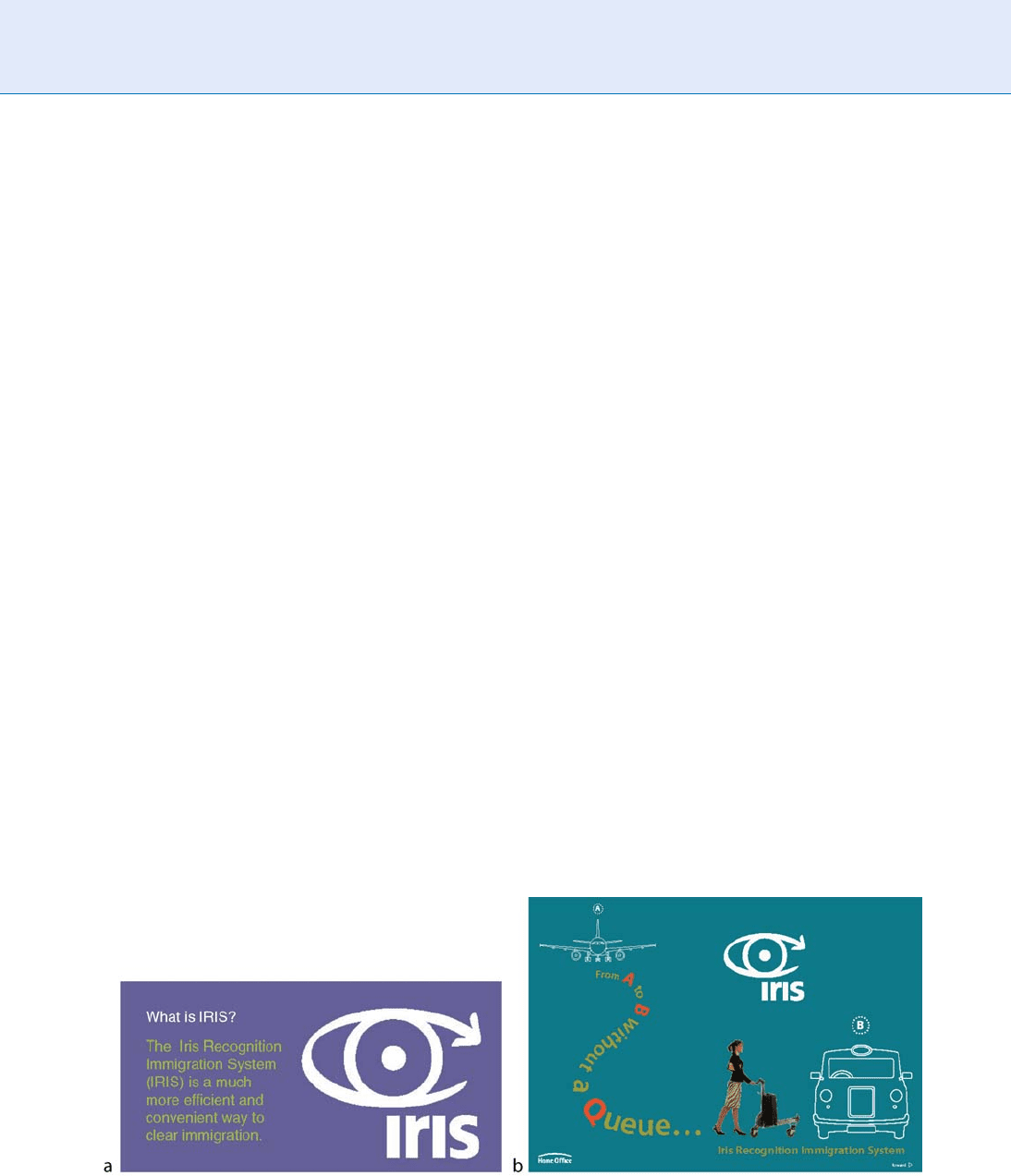
objectives creates special challenges for biometric sys-
tems, because the design strategies and indeed the
core technology choices that may maximize through-
put volumes are not necessarily the same as those
that maximize identification accuracy. This article
reviews five ways in which automated iris recognition
[1] is used within airports and at border-crossings,
with special attention to those trade-offs and design
issues.
Arriving International Passengers:
Iris Recognition Instead of Passport
Presentation at Immigration Control
The use of biometrics as living passports, removing the
need for actual passport presentation at Immigration
control, was pioneered in the UK in 2002. A 6-month
trial of the EyeTicket JetStream system allowed a total of
2,000 frequent travelers from North American to Lon-
don Heathrow Airport to enroll their
▶ IrisCodes and
thereby to bypass Immigration control upon arrival,
passing instead through an automated iris recognition
gate. The trial was deemed fully successful and led
eventually to a large-scale system deployed by the UK
Home Office, called IRIS: Iris Recognition Immigration
System [2]. Based on the same core Daugman algo-
rithms [ 1] but with a more user-friendly interface, the
IRIS system is today deployed at most major UK air-
ports, including all five terminals at Heathrow. The
architecture incorporates a centralized database of en-
rolled IrisCodes so that travelers can use the system
regardless of their airport or terminal, although this
also makes the system vulnerable to interruptions in
communications links or reductions in bandwidth.
Such network failures in the first year of deployment
occasionally inter rupted the service. Nonetheless, as of
May 2008, the UK Border Agency announced that
more than one million passengers had successfully
used the system, with enrollments increasing by
about 2,000 per week, and with the system handling
about 15,000 arrivals per week. By substituting for
passport presentation, the system replaces long queues
at arrivals with an expedited automated clearance at
iris camera gates within a matter of seconds (Fig. 1).
A crucial aspect of the IRIS system is that it oper-
ates in identification mode to determine a passenger’s
identity, not in a mere verification mode in which an
identity is first asserted (for example by presenting a
token, passport, or smartcard) that is then simply
verified. The requirements of biometric operation in
identification mode by exhaustively searching a large
database are vastly more demanding than one-to-one
verification mode in which only a single yes/no com-
parison with one nominated template is required. If P
1
is the False Match probability for single one-to-one
verification trials, then (1P
1
) is the probability of
not making a False Match in single comparisons. The
likelihood of successfully avoiding any in each of N
independent attempts is therefore (1P
1
)
N
, and so P
N
,
Iris Recognition at Airports and Border-Crossings. Figure 1 The UK Government’s IRIS program has enabled more than
a million registered travelers to enter the country via several British airports using only automatic iris recognition for
identification, in lieu of passport presentation or any other means of asserting an identity.
820
I
Iris Recognition at Airports and Border-Crossings
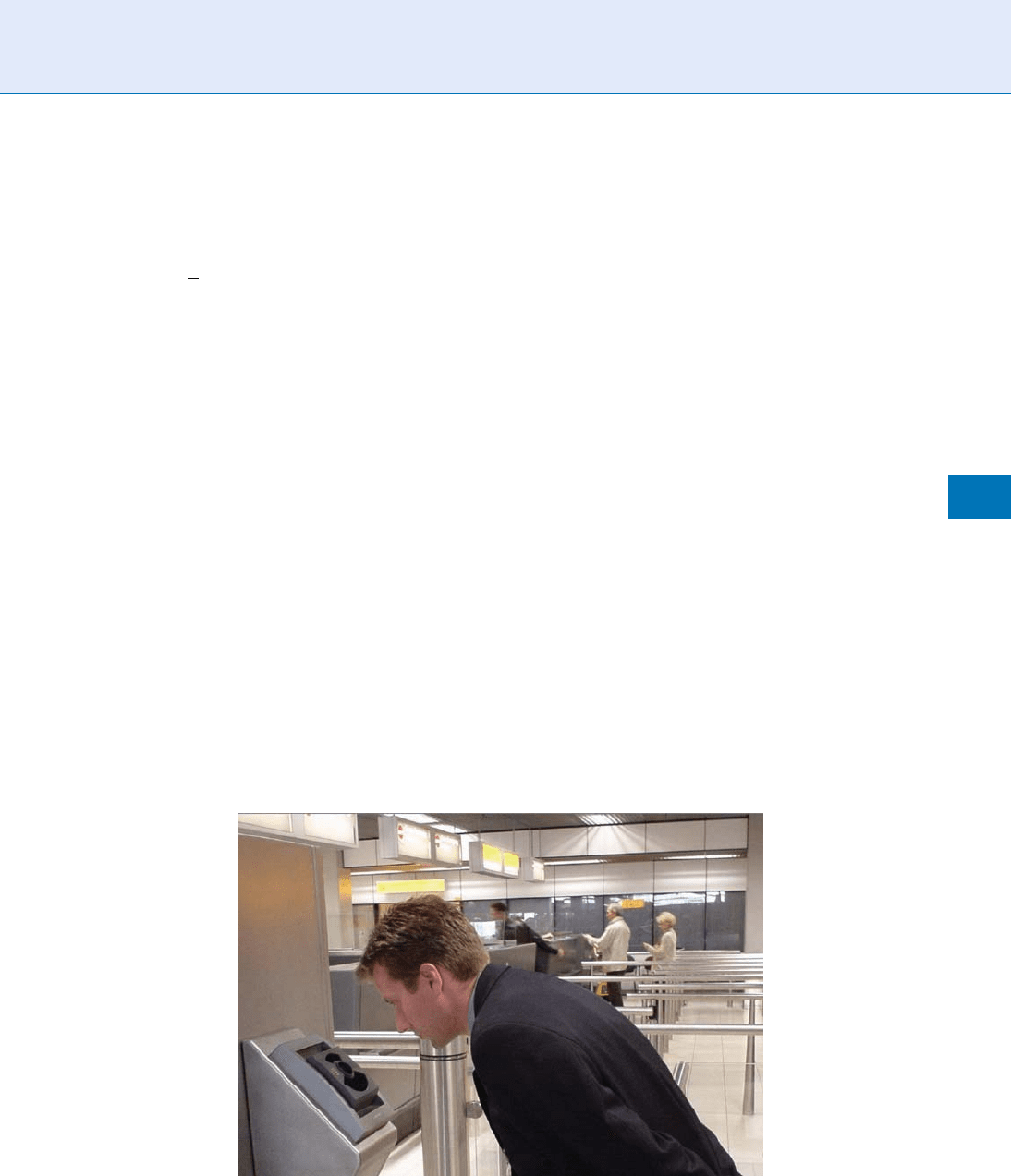
the probability of making at least one False Match
when searching a database containing N different pat-
terns, is
P
N
¼ 1 ð1 P
1
Þ
N
ð1Þ
Observing the approximation that P
N
NP
1
for
small P
1
<<
1
N
<< 1, when searching a database of
size N an identifier needs to be roughly N times better
than a verifier to achieve comparable odds against
making False Matches. In effect, as the database grows
larger and larger, the chance probability of making a False
Match also grows almost in proportion. Obviously the
frequency of False Matches over time also increases
with the frequency of independent searches that are con-
ducted against the database. These considerations make it
vital that such identification applications operating by
exhaustive search use a biometric modality and algo-
rithms that generate score distributions with extremely
rapidly attenuating tails, when different persons are com-
pared. (These issues are discussed and documented in
more detail in the article Score Normalization Rules in
Iris Recognition.) In the absence of such rapidly attenu-
ating distribution tails, the system would drown in
False Matches when the search databases become
large. In this connection, it is noteworthy that in the
UK where the IRIS program optionally replaces pass-
port presentation, the Border Control Development
and Strategy Group forecasts that by 2015, the number
of international passengers entering the UK annually
will exceed 150 million.
Several other countries are also deploying the same
iris recognition algorithms as a substitute for passport
presentation. One of these is The Netherlands, where
iris-based border-crossing has been used since 2003 for
frequent travelers into Amsterdam Schiphol Airport;
members of the Privium program pay an annual fee
to be able to use automated iris gates for clearing
Immigration, in lieu of waiting in queues for pass port
presentation. Another country with a similar but
larger deploym ent is Canada, where the CANPASS
program operates in all the eight international airports
(Edmonton, Winnipeg, Calgary, Halifax, Ottawa,
Montreal, Toronto, and Vancouver) with about 40 kiosks
at each [3]. Both US and Canadian citizens or perma-
nent residents are entitled to enroll in this iris-based
system for entering Canada. In addition, the NEXUS
program operated jointly by the USA and Canada
allows border-crossing in both directions across their
shared border using iris recognition for preapproved
travelers (Fig. 2).
Finally, motorcyclists who commute daily across
the border between Malaysia and Singapore for work
use iris recognition to avoid the long queues for check-
ing passports and ID papers. The Singapore Iris Border
Iris Recognition at Airports and Border-Crossings. Figure 2 At Schiphol Airport (Amsterdam NL), the Privium Program
has a membership of about 40,000 frequent travelers. They pay an annual fee to use the iris recognition system at
automated gates, thereby avoiding the queues at Immigration for passport presentation.
Iris Recognition at Airports and Border-Crossings
I
821
I

Control for Motorcycles allows 3,000 commuters to cross
the border efficiently using ‘‘registered iris’’ lanes with
automated gates, as may be seen in an on-line video
[4]. The motorcyclists in these lanes remain on their
bikes; the gate is equipped from the side with iris
cameras, including one for a passenger on the bike.
Riders must stop and remove their helmets, but they
do not assert their identity. Rather, identification is
performed by exhaustive search of the enrolled iris
database linked to the fully automated gates. The sys-
tem also maintai ns a watch-list that is checked.
Departing Passengers: Expedited Check-
in, Security Screening, and Border
Controls
The US Transportation Security Administration (TSA)
and Department of Homeland Security (DHS) in 2005
began a public/private partnership known as the
Registered Traveler (RT) Program to make airport se-
curity procedures more efficient for departing passen-
gers deemed to be trusted. Under this program, dozens
of US airports have deployed iris and fingerprint recog-
nition systems to confirm the identity of ‘‘trusted tra-
velers’’ who have been vetted by the TSA and approved
for expedited security screening. Bypassing the long
lines that have become a feature of airport security
checkpoints since September 2001 is a benefit for fre-
quent travelers, who pay an annual fee of about $100 for
this privilege. It is also an enhancement for TSA security
processes which can become more focused and can take
advantage of the background vetting that was done
when a person was enrolled in the scheme by virtue of
being deemed a minimum security risk.
Although baggage X-ray and metal detection
checks remain universal, enrollees in these systems
face less intrusive screening (e.g., they can keep their
coats and shoes on and laptops in their bags), and they
enjoy access to a reserved fastlane with shorter delays.
These privileges are asserted by presenting a smartcard
credential that contains their biometric data as well as
other information, all under two layers of encr yption
and readable only by TSA card-readers. Biometric
kiosks in the departure fastlanes read the cards and
confirm passengers’ identity with iris cameras or finger-
print readers. The network is interoperable across some
30 US airports, and the list is steadily expanding [5].
Beginning with Orlando Airport in July 2005, some of
the major participating US airpor ts today include JFK,
LaGuardia, Newark, Dulles, Regan, Denver, and San
Francisco International Airports. The largest such pro-
gram is called CLEAR, operated by Verified Identity
Pass, which had 175,000 enrolled members as of July
2008 [5]. Additional newer participants in the
Registered Traveler public/private partnership with the
TSA include FLO, Unisys, and Vigilant.
In Europe, for travelers who are nationals of the
25 EU countries that have entered into the Schengen
Agreement for harmonized border control, the iden-
tification formalities for crossing into and out of the
Schengen Zone are done by iris recognition at kiosks
in certain airports. The first such deployment was
at Frankfurt/Main Airport and is known as the
Automate d and Biometrics-based Border Checks
(ABG) initiative. This multinational project is led by
Germany’s Federal Ministry of the Interior and Federal
Border Police. The stated objectives of the scheme are
to eliminate the use of fraudulent travel documents
and multiple identities, to speed trusted travelers
across borders, and to allow greater productivity for
border officials.
Iris recognition is also used for other, nonsecurity
related enhancements for departing passengers at air-
ports such as Milan’s Malpensa and Tokyo’s Narita
Airport. Under the Simplifying Passenger Travel scheme
implemented by the Ministry of Justice in Japan, the
JAL Group offers streamlined procedures for passenger
check-in and boarding pass issuance, as well as immi-
gration control at departure and certain ‘‘e-airport’’
utilities and facilities. These services are provided at
iris-enabled automated kiosks and gates in departure
areas, as illustrated in Fig. 3.
Airport Employees: Access Control to
the Tarmac, Aircraft, and Restricted
Areas
Probably the most traditional use of biometric recog-
nition is for physical access control, to ensure that
only authorized persons enter restricted facilities.
This classical mode of biometric deployment is found
at many airports, controlling access to aircraft mainte-
nance facilities, baggage handling areas, the tarmac and
other secure zones.
The Canadian Air Transport Security Authority
uses iris recognition to verify the identities of airport
822
I
Iris Recognition at Airports and Border-Crossings
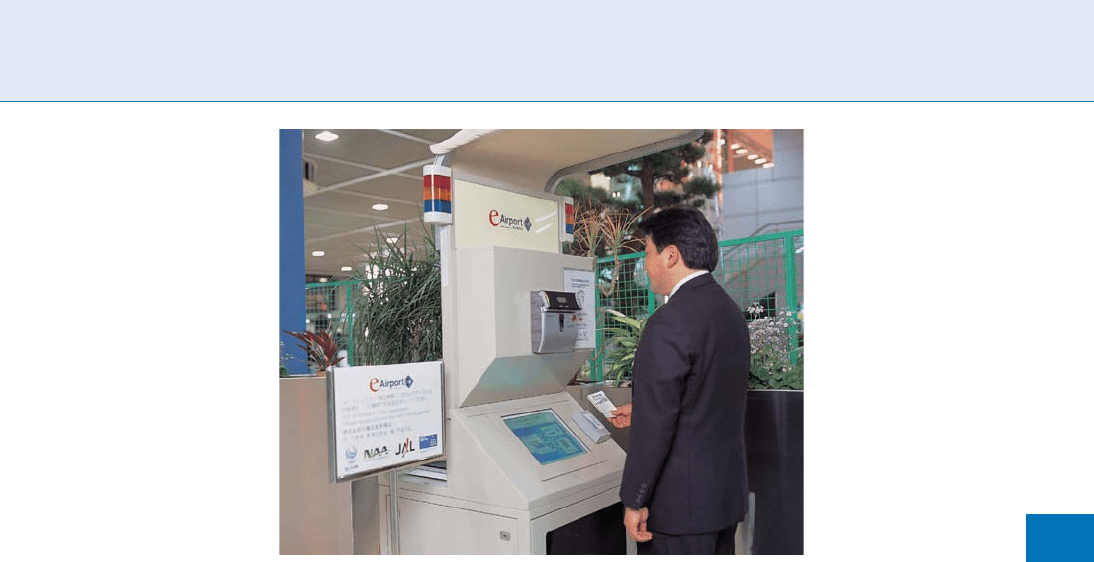
workers at all the 29 major airports in Canada. Iris
biometric data are embedded within an ID card called
RAIC: Restricted Area Identification Card. Workers
must present this card and verify their identities at
iris cameras controlling automated portals. Similar
systems are deployed at Schiphol Airport (Amsterdam)
for 30,000 airport employees; at Albany Airport for
baggage handlers; and at New York JFK Airport
for access to the tarmac at two terminals. Some air-
ports such as Douglas International (Charlotte) have
also deployed iris recognition gates specifically for
pilots and other airline crew members to reach air-
side more efficiently.
Finally, it is noteworthy that an International Stan-
dard specifically related to biometric identification of
airport employees was published in 2008. The ISO/IEC
24713-2 Standard gives normative requirements on
Biometric Profiles for Interoperability and Data Inter-
change: Physical Access Control for Employees at Airports
[6]. The scope of this Standard includes recommended
practices for enrollment, watch-list screening, preven-
tion of duplicate token issuance, and employee identity
verification. It also describes architectures and business
processes appropriate to token-based identity manage-
ment within the secure environment of an airport.
Watch-list Screening of Arriving
Travelers
The rapid search capabilities of iris recognition, and its
robustness against making False Matches despite the
fact that large search databases create many opportu-
nities for such errors, have led to the deployment of
this technology for watch-list screening. The largest
such deployment is in the United Arab Emirates,
where visa-bearing travelers arriving at any of the
32 air, land, and sea ports of entry are processed with
iris recognition cameras as illustrated in Fig. 4.
Known as the Expellee Tracking and Border Security
Iris System, the scheme was launched in 2001 by the
UAE Ministry of Interior. A noteworthy aspect of the
UAE is that among its 5.4 million residents, about 85%
are foreign nationals [7] on work permits. Because of
this large foreign labor force drawn by economic
opportunities much better than elsewhere in the Mid-
dle East and Sou th Asia, men outnumber women by a
factor of 2.74 among persons in the 15–65 age group
[7], and the border-crossing volume of migrant work-
ers whose homeland roots are elsewhere is very high
(some 12,000 per day). In 2001 an amnesty was
granted to all foreign nationals who had overstayed
Iris Recognition at Airports and Border-Crossings. Figure 3 In the e-airport deployment at Tokyo Narita Airport, iris
recognition is used for expedited check-in of departing passengers. In dozens of US airports, Registered Travelers
approved by the Transportation Security Administration receive expedited security screening once their identities are
proved by fingerprint or iris recognition.
Iris Recognition at Airports and Border-Crossings
I
823
I
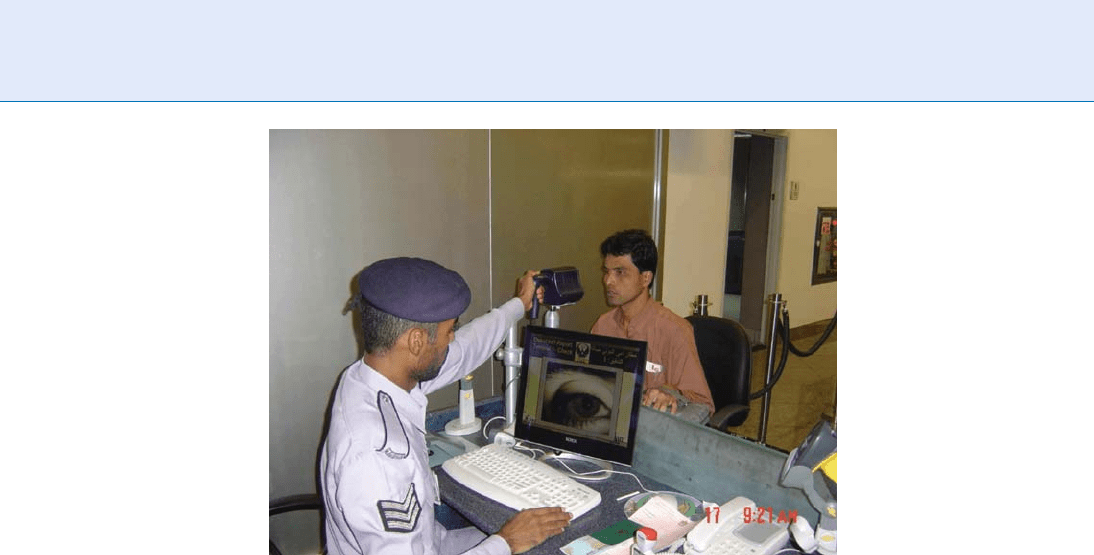
their work permits or committed other visa violations,
but a condition of the amnesty waiver of penalties was
that such persons were expelled from the Emirates for
some period of time, and their iris patterns were
registered in a database. This action enabled enforce-
ment of the ban on re-entry and defeated thousands of
attempts to return under false identities and with fake
travel documents. Over the period 2001–2007 the da-
tabase of expellees’ IrisCodes was enlarged with Iris-
Code databases of foreign nationals who had been
imprisoned for crimes such as prostitution or drugs
trafficking, and of persons deemed to be security risks
or unwelcome for other reasons.
Today this iris watch-list contains 1.2 million Iris-
Codes from persons of 156 nationalities. All travelers
seeking visa entry into the UAE via any port have their
iris images acquired by cameras as shown in Fig. 4,so
that their IrisCodes can be computed and matched
exhaustively against the full database. Since on average
some 12,000 such persons arrive at the UAE each day,
about 14 billion IrisCode comparisons are performed
daily across a dedicated network. The IrisFarm archi-
tecture is a distributed host/cl ient system with a single
central database maintained by the Abu Dhabi Police,
linked over a network of comm unication channels to
clients that send IrisCode queries to it from all ports
of entry. The average turn-around time is about 2s.
Because every query IrisCode is compared exhaustively
with all on the watch-list, the total volume of such iris
comparisons performed over the years of operation
now number in many trillions [8]. Tens of thousands
of persons have been caught trying to re-enter the UAE
under false identities, who are turned away but who
often make repeated attempts, and the UAE Ministry
of Interior hails the system as a huge success. The
system is now expanding into neighboring Gulf States
including Jordan and Oman, and it will be linked with
an iris-based national identity and border-crossing
system being procured in the Kingdom of Saudi
Arabia.
System Design Contrasts and
Vulnerabilities
The most important differences among the various
systems reviewed in this article are (1) whether they
operate in identification mode, in which no identity is
asserted but identity is determined by searching a
database, versus verification mode in which a token
like a smartcard is used to assert a particular identity
that is then simply verified one-to-one; and (2) whether
the objectives of a valid user or an attacker are to be
matched to an identity on a database, or not.
Identification is vastly more demanding than one-
to-one verification, both in terms of search space and
Iris Recognition at Airports and Border-Crossings. Figure 4 In the United Arab Emirates deployment of iris
recognition at all the 32 air, land, and sea ports, travelers are screened against a watch-list of expellees, or persons
deemed to be a security risk, before being allowed to enter the Emirates.
824
I
Iris Recognition at Airports and Border-Crossings
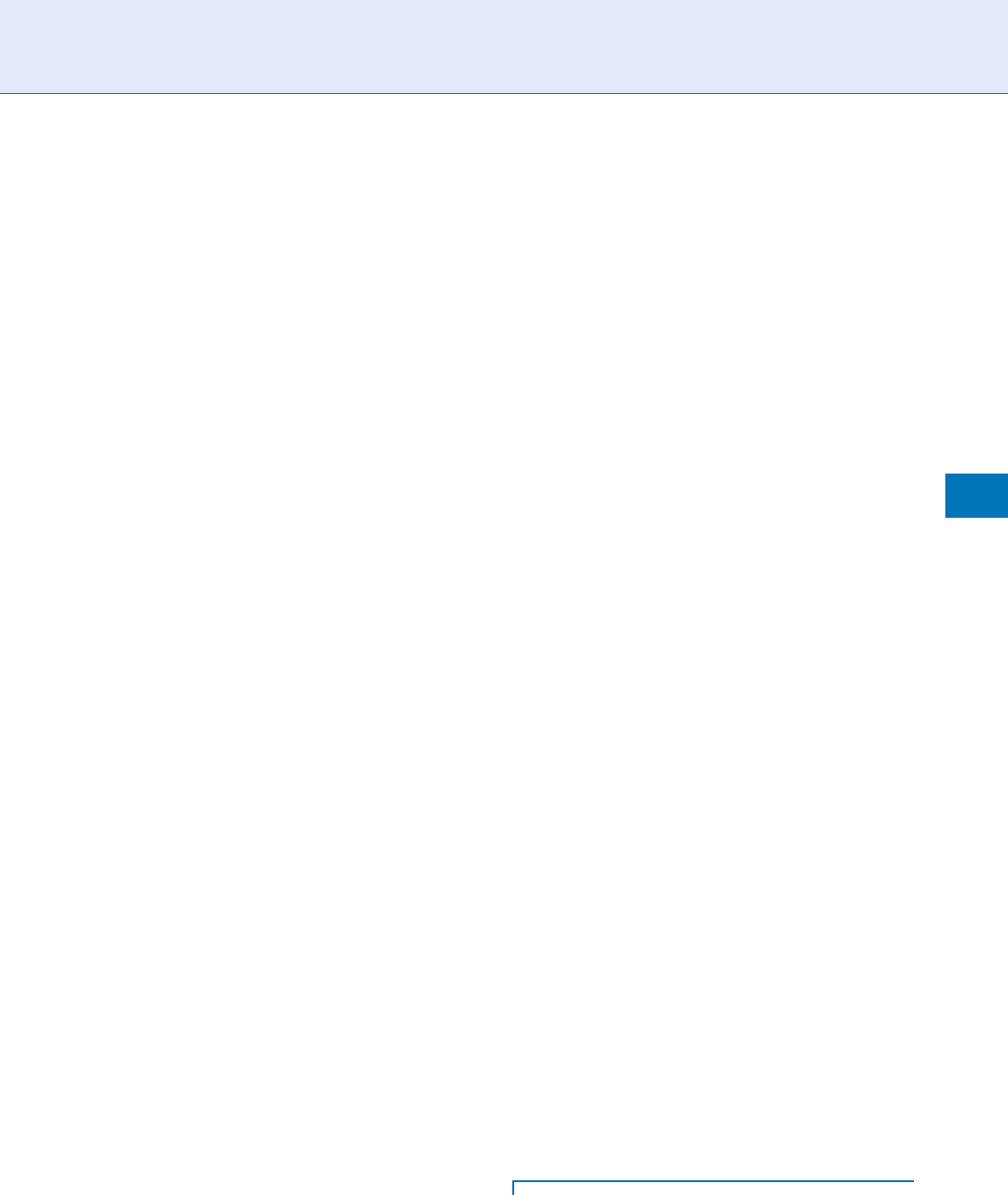
comparison speeds, and in terms of the requirement to
avoid any False Matches despite what may be a huge
number of opportunities to make them if the database
is large. If a weak biometric system such as face recog-
nition is used, an attac ker would have an excellent
chance to be matched just by chance against at least
one person in a trusted traveler database, if that were
the only test and if the database were larger than a few
hundred or perhaps a thousand. For this reason,
weaker biometrics rely on smartcards or other tokens
to assert a particular identity, so that only one com-
parison must be executed successfully. But presenta-
tion of a token makes the process more cumbersome,
and in any case it has no value for watch-list screening .
Nearly all deployments of iris recognition operate
in identification mode by exhaustive search of a data-
base, because the technology’s speed and accuracy
allow it. The exceptions to this mode are (1) the Pri-
vium system because Dutch law forbids the storage by
the State of personal data like biometrics, and so the
citizens alone retain it; and (2) the CLEAR program
because a smartcard is used for several other purposes
in the transaction anyhow. In both of these cases the
use of a storage token makes it unnecessary to perform
identification by searching a database.
In identification system s operating by database
search, it is necessary to combat the inevitable net
increase in the likelihood of chance False Matches as
the size of the search databases grow. This form of
probability summation is the same phenomenon as
arises when playing the game of Russian Roulette an
increasing number of times. In the case of the iris
recognition algorithms [1, 8] used in all current iris
deployments, combatting this is accomplished by min-
ute adjustments in the decision threshold with search
database growth, keeping the net False Match proba-
bility minuscule. Further details about these processes
are given in the accompanying article, Score Normali-
zation Rules in Iris Recognition.
In a trusted traveler scheme (CLEAR, IRIS, Pri-
vium, etc.), the objective of an attacker is to imperson-
ate another person – either a particular person, or
anyone at random just by accident – who is registered
in the trusted database. The likelihood of success by
blind chance (a ‘‘zero effort attack’’) is minuscule in
the case of iris, but much higher if a printed contact
lens can be produced to mim ic a particular target
individual’s iris. In a watch-list deployment such as
the UAE one, the objective of an attacker is simply to
look like anybody other than himself (or anyone else
registered in the watch-list). Such a ‘‘concealment at-
tack’’ by means of printed contact lenses is easier than
an ‘‘impersonation attack,’’ and indeed it can even be
attempted simply by being uncooperative. Therefore,
these border securit y system s incorporate tests for the
vitality, or ‘‘liveness,’’ of iris patterns including their
motion and deformation with changes in the pupil
size, which obviously does not occur if printed on a
contact lens. Similarly, the standard algorithms per-
form biometric quality assessments to detect extremely
dilated pupils or excessively closed eyelids, as indica-
tors of possible attacks. However, the struggle between
countermeasure and new counter-countermeasure
continues and escalates relentlessly.
Related Entries
▶ Iris Encoding and Recognition Using Gabor
Wavelets
▶ Score Normalization Rules in Iris Recognition
References
1. Daugman, J.G.: How iris recognition works. IEEE Trans. Circuits
Syst. Video Technol. 14, 21–30 (2004)
2. UK Border Agency, Project IRIS website. http://www.ukba.
homeoffice.gov.uk/managingborders/technology/iris/
3. Canadian Border Services Agency, CANPASS website. http://
cbsa-asfc.gc.ca/publications/pub/bsf5017-eng.html
4. Singapore Iris-Based Border Control for Motorcyclists. http://
www.youtube.com/watch?v=HieaASl9sE8&feature=related
5. CLEAR Verified Identity Pass website. http://www.flyclear.com
6. International Organisation for Standards: Biometric Profiles for
Interoperability and Data Interchange, Part 2: Physical Access
Control for Employees at Airports. ISO/IEC 24713-2 (2008)
7. Demographics of UAE, 2008. http://en.wikipedia.org/wiki/
United_Arab_Emirates
8. Daugman, J.G.: Probing the uniqueness and randomness of
IrisCodes: results from 200 billion iris pair comparisons. Proc.
IEEE 94, 1927–1935 (2006)
Iris Recognition Immigration System
(IRIS)
▶ Iris Recognition at Airports and Border-Crossings
Iris Recognition Immigration System (IRIS)
I
825
I
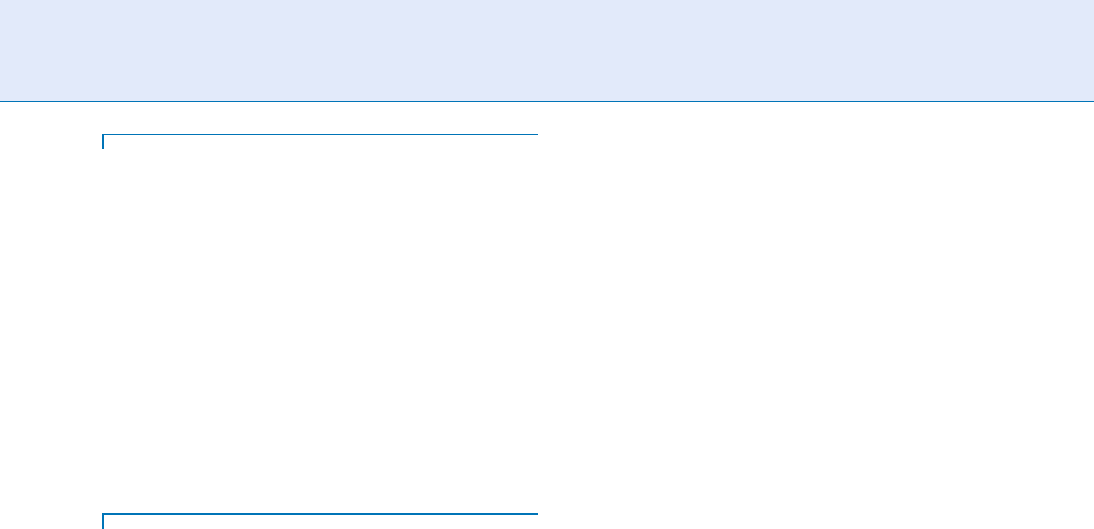
Iris Recognition Operational Range
The maximal transversal region along the optical axis
of an imaging system within which an iris recognition
algorithm provides accurate identification. Typically,
iris recognition operational range is significantly af-
fected by the system’s depth of field.
▶ Wavefront Coded
1
Iris Biometric Systems
Iris Recognition Performance
Under Extreme Image Compression
JOHN DAUGMAN,CATHRYN DOW NI N G
Computer Laboratory, Cambridge University,
Cambridge, UK
Definition
The compressibility of images is usually gauged by their
subjective appearance and by metrics for the amount
of distortion that can be tolerated. In the context of
biometrics, compressibility can be gauged objectively
by measuring the impact of compression schemes on
recognition performance compared to baseline perfor-
mance. Standard biometric methodologies such as
Receiver Operating Characte ristic (ROC) curves are
perfectly suited for measuring the impact of compres-
sion on performance. It is possible for performance
actually to benefit from slight image compression, as
has been seen both with fingerprint and iris recogni-
tion, because high frequency noise is the first thing lost;
but at more severe levels, compression must become
detrimental. For iris recognition, it is possible to com-
press images to as little as 2,000 bytes through a combi-
nation of methods including cropping, region-of-interest
(ROI) isolation and JPEG2000 wavelet coding, while
suffering only a little reduction in recognition perfor-
mance. This is important because Governments and
Standards organizations prefer that biometric data be
stored in a relatively raw, unprocessed form in order to
remain algorithm-neutral and future-proof. It is also
mathematically important because of insights from
information theory and complexity theory related to
minimal description length, entropy, compressibility,
and discriminability.
Introduction
A watershed event in biometric informatics occurred in
1993 when the FBI digitized a vast library of fingerprint
cards that had been stored in acres of filing cabinets
and adopted the Wavelet Scalar Quantization (WSQ)
protocol [1] to compress these images, achieving com-
pression ratios in the range of 10:1 or 15:1 without
detectable loss of detail. Compressibility is a fundamen-
tal issue for biometrics, not only for mundane practical
reasons related to storage requirements and data trans-
mission times, but also for abstract mathematical rea-
sons related to information content and pattern
recognition. Governments, regulatory bodies, and inter-
national standards organizations often mandate the
storage of relatively raw data rather than processed
biometric templates, hoping thereby to preserve inter-
operability and to keep biometric data ‘‘vendor-neutral
and future-proof’’ while the algorithms for pattern de-
scription and recognition inevitably evolve and im-
prove. But raw images as data objects are almost a
thousand times larger than the biometric templates
ultimately computed from them. Hence, the conflicting
goals of reducing the size yet preserving the information
content of biometric data make it important to under-
stand how various possible compression schemes im-
pact on biometric recognition performance. This article
studies these questions in the context of iris recognition,
and reviews data [2] showing that it is possible to
compress iris images to within about a factor of two
of the standard iris biometric template sizes with al-
most no impact on recognition performance.
Information Theory and Data
Compressibility
Data compression is one of several disciplines rooted
in information theory having relevance to biometric
technologies for identifying persons, and its signi-
ficance extends beyond the practical matters of storage
requirements and data transmission times. One
of Shannon’s fundamental insights in formulating
826
I
Iris Recognition Operational Range
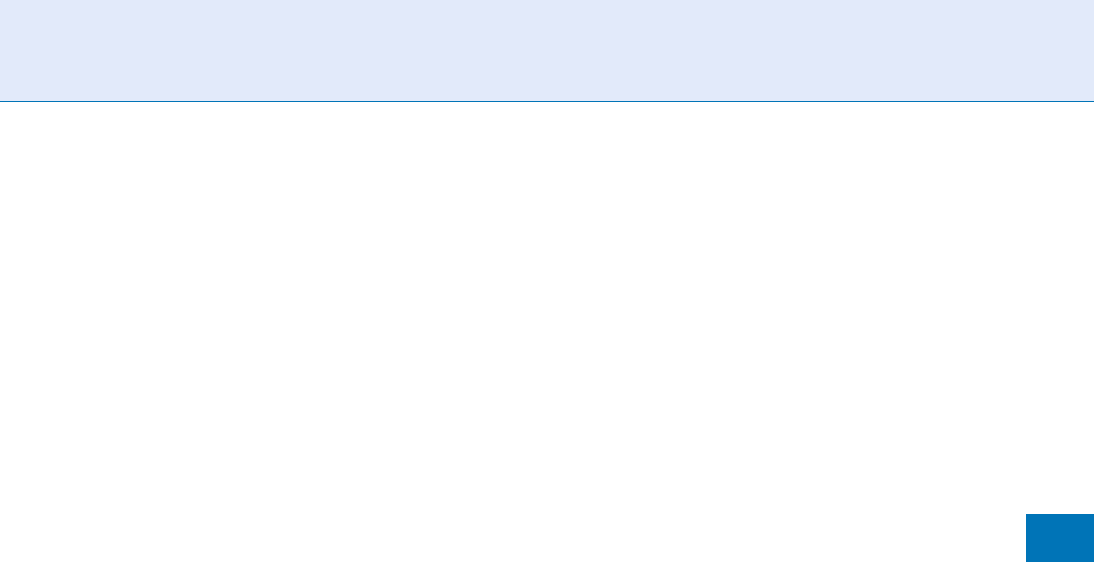
information theory [3] was that the entropy of a ran-
dom variable measures simultaneously its information
content (expressed in bits) and its compressibility with-
out loss (to the same number of bits). This link between
entropy, informativeness, and compressibility extends
also to other measures that apply to biometrics. For
example, the relative entropy between two distributions
is one way to measure how well a biometric technique
separates samples from same versus different persons.
The amount of variability in a given biometric system
across a population, or in different samples from the
same source, is also captured by conditional entropies,
with larger entropy signifying greater randomness. Fi-
nally, the similarity between pairs of biometric tem-
plates is reflected by their mutual information: the
extent to which knowledge of one sample predicts the
other. All of these properties are deeply connected with
the compressibility of biometric data.
An extreme variant of Shannon’s insight was
expressed by Kolmogorov [4] in his notion of minimal
description length, which defined the complexity of a
string of data as the length of the shortest binary
program that could generate the data. Creating that
program ‘‘compresses’’ the data; executing that pro-
gram ‘‘decompresses’’ (generates) the data. Fractal
image compression is based on this idea; and a data
string is said to be Kolmogorov incompressible if the
shortest program that can generate it is essentially a
data statement containing it, so the data are then their
own shortest possible description. Within biometrics,
this notion has appeared implicitly under a different
rubric in work on syntheti c biometrics, seeking method s
for artificially synthesizing a biometric image that is
indistinguishable in practice from some actual biomet-
ric image. Pioneering work in this direction was done
by Terzopoulos and Waters [5] for facial images and
sequences, by Cappelli et al. [6] for fingerprints, and by
Cui et al. [7] and by Zuo et al. [8] for iris images. In
future, such programs for generating particular bio-
metric images might therefore serve as ways to ‘‘com-
press’’ them in Kolmogorov’s sense; and one might
even anticipate biometric recognition by comparison
of the synthesizing programs. The present article
explores a combination of image compression meth-
ods applied to iris images, specifically probing the
question of how aggressively they can be compressed
without impairing iris recognition. A convergence be-
tween compressed image size and biometric descrip-
tion length begins to emerge.
Schemes for Iris Image Compression
Iris templates (e.g., ▶ IrisCodes) are usually computed
from a polar or pseudo-polar coordinate mapping of
the iris, after locating its inner and outer boundaries
[9, 10, 11]. However, if simple circular boundary mod-
els are imposed, polar mappings depend strongly upon
the choice of origin of coordinates which may be prone
to error, uncertainty, or inconsistency, especially since
the true iris boundaries are often not actually circular.
Unlike rectilinear coordinates, for which a shift error
has no more effect than a shift, in polar coordinate
mappings a shift error in the choice of coordinate
origin can cause large distortions in the mapped data,
with no way to recover from the deformed sampling.
A pioneering study of iris compressibility was
undertaken by Rakshit and Monro [11] showing that
if segmented and normalized iris data were extracted in
polar form, this ‘‘unwrapped’’ polar data structure
could be compressed to 2,560 bytes or even less with-
out impairing recognition performance. However, be-
cause this approach stores the iris image in polar form,
it is not robust against errors in assigning the origin of
coordinates or the loss of iris data when circular bor-
ders are inappropriately enforced. It also suffers from
making the accurate detection of eyelid boundaries for
exclusion of eyelid regions very difficult, since the
available pixel data is tightly cropped around the iris
and ignores valuable shape-constraining data from the
boundary betw een sclera and eyelid. Finally, the polar
unwrapping has the consequence of highly nonuni-
form sampling, with pixels near the outer perimeter
of the iris sampled with a density 2.5 times lower than
those near the pupil. Preservation of the original recti-
linear format of an iris image is more veridical than
polar unwrapping methods because pixels retain con-
stant size and spac ing.
Avoiding the problems introduced by polar unwrap-
pings of iris images, the authors [2] investigated three
compression schemes that retain the native rectilinear
image array format but compress it to as little as
2,000 bytes while still allowing very good recognition
performance on the difficult Iris Challenge Evaluation
(ICE-1) iris database available from the National Insti-
tute of Standards and Technology (NIST) [12] which
includes many poor quality images. Interoperability
was documented between those images when subjected
to the three compression regimes and their uncom-
pressed form, and it was found that on average only
Iris Recognition Performance Under Extreme Image Compression
I
827
I

2–3% of the bits within the computed IrisCodes are
affected even when the net image data reduction factor
reaches 150:1.
Tools for Iris Image Compression:
JPEG, JPEG2000, Region-of-Interest
Extraction
Clearly, a first step in image data reduction is to crop
the iris images from the stand ard format of 640 480
pixels with 8 bits grayscale data per pixel, consuming
307,200 bytes, to a smaller region of 320 320 pixels
centred on the iris. This was done by running the eye-
finding part of the standard algorithms [10] that are
used in all current public deployments of iris recogni-
tion, on all images in the publicly available NIST [ 12]
ICE1Exp1 datab ase, which contains 1,425 iris images
from 124 Subjects with ‘‘ground-truth’’ information
given about which images were taken from the sam e
iris. The algorithms correctly localized the iris in all
images and produced from each one a new cropped
image of 320 320 pixels with the iris centred in it. For
those NIST images in which the iris was partly outside
of the original image frame, the missing pixels were
automatically replaced with black ones. For those in
which the algorithms detected that the gaze was direct-
ed away from the camera, as gauged by projective
deformation of the eye shape, a corrective affine trans-
formation was automat ically applied which effectively
‘‘rotated’’ the eye in its socket into orthographic per-
spective on-axis with the camera. The first column of
Fig.1 shows three examples of iris images cropped as
described earlier.
This new gallery of simply cropped images was
subjected to three different compression schemes: (1)
▶ JPEG compression with quality factors (QF) of 70,
30, and 20; (2) JPEG compression with the same QFs
but after
▶ Region-of-Interest (ROI) segmentation;
and (3)
▶ JPEG2000 compression after ROI segmenta-
tion with compression factors (CF) of 20, 50, and 60, as
illustrated in the second column of Fig.1 for the case of
CF¼50.
The use of cropping and JPEG compression alone
(with QFs of 70, 30, and 20) produced image file sizes
averaging 12,400, 5,700, and 4,200 bytes, respectively,
but with large variability around these means. Includ-
ing the initial threefold reduction in file size due merely
to cropping the imag es to 320 320 pixels, these net
data reduction factors relative to the original full-size
images therefore average 25:1, 54:1, and 72:1, respec-
tively. But fur ther significant reductions in image data
size can be achieved through the use of ROI segmenta-
tion of the iris image.
The standard lossy JPEG coding scheme [13, 14]
effectively allocates bytes on an ‘‘as needed’’ basis,
meaning that the cost of encoding uniform regions of
an image is almost nil, whereas image areas containing
busy textures such as eyelashes may consume much of
the available informati on budget. In uniform regions,
the only nonzero DCT (discrete cosine transform)
coefficient in each block of 64 frequency components
that encode an 8 8 pixel block (a data unit) is the DC
coefficient specifying their average gray value; all other
coefficients are 0 if the data unit is a truly uniform
region, or else become 0 after coarse quantization, and
so their cost in the zeroes run-length coding stage is
essentially nil. Therefore JPEG encoding of iris image s
can be made much more efficient if all noniris parts of
the image are replaced with a uniform gray value. This
was accomplished for the image gallery automat ically
using the standard algorithms [10] for eyelids detec-
tion and fitting, and iris boundary localization, as seen
in the second column of Fig.1.
JPEG coding schemes lend themselves well to ROI
differential assignment of the coding budget. Indeed
the JPEG2000 standard [15, 16, 17] and even the Part 3
extension of the old JPEG standard [13, 14], support
variable quantization for explicitly specifying different
quality levels for different image regions. In JPEG2000,
the MAXSHIFT tool allows specification of an ROI of
arbitrary shape. This utility was explored for biometric
face recognition by Hsu and Griffin [18] who demon-
strated that recognition performance was degraded by
no more than 2% for file sizes compressed to the range
of 10,000–20,000 bytes with ROI control.
In the approach to ROI segmentation presented
here, noniris regions are encoded in a way that distin-
guishes sclera from eyelids or eyelashes regions, so that
postcompression algorithms can still determine both
types of iris boundaries. Therefore two different sub-
stitution gray levels are used: a darker one signifying
eyelids, and a brighter one for the sclera, computed as
an average of actual sclera pixels and blending into
actual sclera pixels near the iris outer boundary. Since
the substitution gray levels are uniform, their coding
cost is minimal and could be further reduced by using
larger data units. JPEG compression of such ROI seg-
mented iris images typically yields a further twofold
reduction in file size for each of the QFs studied, while
828
I
Iris Recognition Performance Under Extreme Image Compression
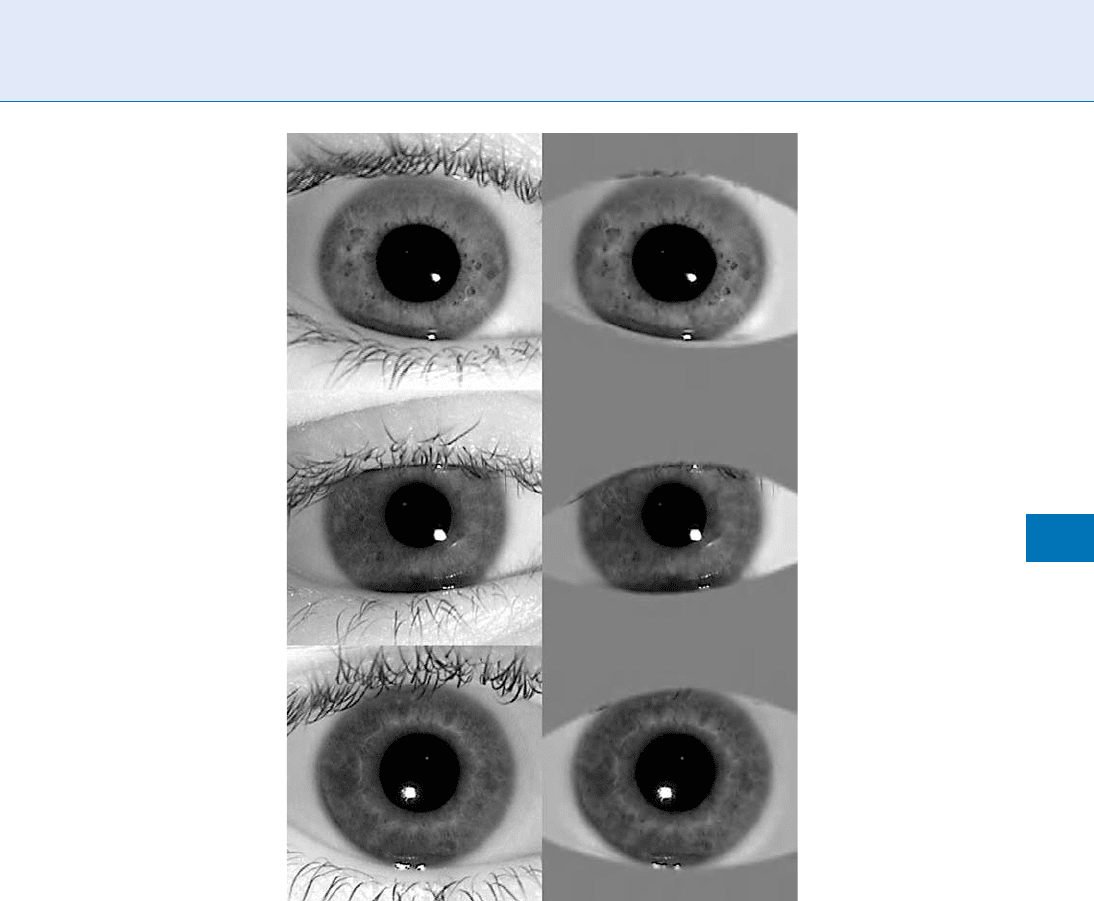
maintaining a simple rectilinear image format and easy
localization of eyelid boundaries in later stages.
In 2000 a more powerful version of JPEG coding
offering more flexible modes of use, and achieving
typically a further 20–30% compression at any given
image quality, was adopted as the JPEG2000 Stan-
dard [16, 17]. Mathematically based on a Discrete
Wavelet Transform (DWT) onto Daubechies wavelets
rather than the Discrete Cosine Transform (DCT),
JPEG2000 does not suffer as badly from the block
quantization artifacts that bedevil JPEG at low bit-
rates, which are due to the fact that the DCT simply
chops cosine waves inside box windows with obvious
truncation consequences when they are sparse and
incomplete. Moreover, the different levels within the
multiresolution DWT wavelet decomposition allow
local areas with in each image data unit to be encoded
using different subbands of coefficients [17] as need ed.
The net superiori ty of JPEG2000 over JPEG in terms of
image quality is especially pronounced at very low bit-
rates corresponding to severe compression, as investi-
gated here, in the range of 0.15 bits/pixel (bpp).
Several mechanisms exist within JPEG2000 for het-
erogeneous allocation of the coding budg et, including
tile (data unit) definition, code-block selection allow-
ing different DWT resolution levels in different tiles,
Iris Recognition Performance Under Extreme Image Compression. Figure 1 Cropping of iris images (first column),
followed by region-of-interest isolation of the iris (second column) to achieve greater compressibility while retaining a
rectilinear image array format. Substitution of noniris regions by uniform gray levels prevents wasting wavelet coding
budgets on costly irrelevant structures such as eyelashes. All images in the second column have been JPEG2000
compressed to a data size of only 2,000 bytes.
Iris Recognition Performance Under Extreme Image Compression
I
829
I
